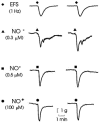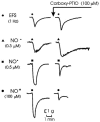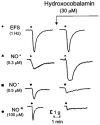Comparison of the redox forms of nitrogen monoxide with the nitrergic transmitter in the rat anococcygeus muscle
- PMID: 10433488
- PMCID: PMC1566077
- DOI: 10.1038/sj.bjp.0702540
Comparison of the redox forms of nitrogen monoxide with the nitrergic transmitter in the rat anococcygeus muscle
Abstract
1. A sustained tone was produced in rat isolated anococcygeus muscles with guanethidine and clonidine and relaxant responses were elicited by electrical stimulation of its nitrergic nerves and by the three redox forms of nitrogen monoxide. 2. The nitroxyl anion (NO ) was donated by dissociation of Angeli's salt; the free radical (NO*) was from an aqueous solution of nitric oxide gas; the nitrosonium cation (NO+) was donated by dissociation of nitrosonium tetrafluoroborate. 3. The concentrations producing approximately 50% relaxations of the anococcygeus muscle were 0.3 microM for Angeli's salt (nitroxyl), 0.5 microM for NO* and 100 microM for nitrosonium tetrafluoroborate. Nitrergic nerve stimulation at 1 Hz for 10 s produced equivalent relaxant responses. 4. The superoxide generator pyrogallol (100 microM) had no effect on responses to nitrergic nerve stimulation or Angeli's salt but significantly reduced responses to NO* and nitrosonium tetrafluoroborate. 5. The NO* scavenger carboxy-PTIO (100 microM) had no effect on responses to nitrergic nerve stimulation or Angeli's salt but significantly reduced responses to NO* and nitrosonium tetrafluoroborate. 6. Hydroxocobalamin (30 microM) had no significant effect on responses to the nitrergic transmitter, enhanced the response to Angeli's salt, and significantly reduced responses to NO* and nitrosonium tetrafluoroborate. 7. The findings suggest that the nitroxyl anion donated by Angeli's salt is a better candidate than NO* to serve as the nitrergic transmitter in the rat anococcygeus muscle, although it still does not behave exactly like the transmitter.
Figures








Similar articles
-
Effects of agents that inactivate free radical NO (NO*) on nitroxyl anion-mediated relaxations, and on the detection of NO* released from the nitroxyl anion donor Angeli's salt.Br J Pharmacol. 2001 Oct;134(3):521-8. doi: 10.1038/sj.bjp.0704287. Br J Pharmacol. 2001. PMID: 11588105 Free PMC article.
-
Enhanced responsiveness to nitric oxide, nitroxyl anions, and nitrergic transmitter by 3-(5'-hydroxymethyl-2'-furyl)-1-benzyl indazole in the rat anococcygeus muscle.Nitric Oxide. 2005 Sep;13(2):118-24. doi: 10.1016/j.niox.2005.05.007. Nitric Oxide. 2005. PMID: 15993633
-
Nitrergic relaxation in urethral smooth muscle: involvement of potassium channels and alternative redox forms of NO.Naunyn Schmiedebergs Arch Pharmacol. 2001 Dec;364(6):516-23. doi: 10.1007/s002100100480. Naunyn Schmiedebergs Arch Pharmacol. 2001. PMID: 11770006
-
The nitrergic transmitter of the anococcygeus--NO or not?Arch Int Pharmacodyn Ther. 1995 Jan-Feb;329(1):39-51. Arch Int Pharmacodyn Ther. 1995. PMID: 7543747 Review.
-
Superoxide anions, free-radical scavengers, and nitrergic neurotransmission.Gen Pharmacol. 1997 Apr;28(4):489-93. doi: 10.1016/s0306-3623(96)00281-9. Gen Pharmacol. 1997. PMID: 9147013 Review.
Cited by
-
Nitroxyl (HNO) stimulates soluble guanylyl cyclase to suppress cardiomyocyte hypertrophy and superoxide generation.PLoS One. 2012;7(4):e34892. doi: 10.1371/journal.pone.0034892. Epub 2012 Apr 10. PLoS One. 2012. PMID: 22506056 Free PMC article.
-
Aorta from angiotensin II hypertensive mice exhibit preserved nitroxyl anion mediated relaxation responses.Pharmacol Res. 2012 Jan;65(1):41-7. doi: 10.1016/j.phrs.2011.07.002. Epub 2011 Jul 8. Pharmacol Res. 2012. PMID: 21767645 Free PMC article.
-
Influence of antioxidant depletion on nitrergic relaxation in the pig gastric fundus.Br J Pharmacol. 2002 Feb;135(4):917-26. doi: 10.1038/sj.bjp.0704553. Br J Pharmacol. 2002. PMID: 11861319 Free PMC article.
-
Vascular smooth muscle relaxation mediated by nitric oxide donors: a comparison with acetylcholine, nitric oxide and nitroxyl ion.Br J Pharmacol. 2001 Oct;134(3):463-72. doi: 10.1038/sj.bjp.0704269. Br J Pharmacol. 2001. PMID: 11588100 Free PMC article.
-
Influence of bilirubin and other antioxidants on nitrergic relaxation in the pig gastric fundus.Br J Pharmacol. 2000 Mar;129(6):1201-11. doi: 10.1038/sj.bjp.0703176. Br J Pharmacol. 2000. PMID: 10725269 Free PMC article.
References
-
- AKAIKE T., YOSHIDA M., MIYAMOTO Y., SATO K., KOHNO M., SASAMOTO K., MIYAZAKI K., MAEDA H. Antagonistic action of imidazolineoxy N-oxides against endoethlium-derived relaxing factor/.NO through a radical reaction. Biochem. 1993;32:827–832. - PubMed
-
- BOECKXSTAENS G.E., PELCKMANS P.A., BOGERS J.J., BULT H., DE MAN J.G., OOSTERBOSCH L., HERMAN A.G., VAN MAERCKE Y.M. Release of nitric oxide upon stimulation of non-adrenergic, non-cholinergic nerves in the rat gastric fundus. J. Pharmacol. Exp. Ther. 1991a;256:441–447. - PubMed
-
- BULT H., BOECKXSTAENS G.E., PELCKMANS P.A., JORDAENS F.J., VAN MAERCKE Y.M., HERMAN A.G. Nitric oxide as an inhibitory non-adrenergic non-cholinergic neurotransmitter. Nature. 1990;345:346–347. - PubMed
Publication types
MeSH terms
Substances
LinkOut - more resources
Full Text Sources

